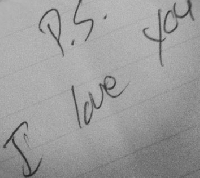
What does ps mean and how to use it
Today many of us turn to email or a text message if we have something to tell someone. We post random thoughts and share everything from family photos to what we ate for lunch on social media. So it’s not surprising that the definition of a familiar term has become a bit fuzzy.
Think back to the last time you wrote a letter to a friend or someone you love. How many times have you thought of something else to say just after signing off. If it’s typed, you could go back and add it in, but that can ruin the whole flow of a carefully crafted letter. What do you do?
This is where the postscript comes in, a friendly afterthought. You may know it as what comes after P.S.. If you’ve ever wondered what does P.S. mean, refer back to its origin. The letters are an acronym for the Latin phrase meaning post scriptum. This directly translates to after (post) writing (scriptum).
The reader sees your added remark with equal importance as the rest of the letter. Since it’s the last words read, it’s often the first thing remembered. What you may think of as an incidental afterthought, can re-set the tone for the whole correspondence. The best ones make the recipient smile, maybe even blush.
~
You may also find them on a holiday greeting card or wedding invitation. Say your best friend is getting married and yours is one of two hundred invites. Any side notes she wants to add at the end, after all of the basic details, will likely come as a postscript (the English term).
This is used whether a letter is friendly, romantic or business related. Since humans first invented ways to communicate with one another from a distance they’ve always had something extra to say after the letter’s closing, especially in love letters.
When to use it
Being on the receiving end of one is almost always a good thing, but how to use it in your own correspondences may still be unclear. If you happen to be at work worrying the meaning of P.S., calm down. At work people organize their thoughts by relevance, and any side notes naturally go after the closing.
Colleagues, clients and bosses tend to be concise and focused in the emails or letters. If they have something to add that’s not related to the letter’s topic, they may add it as a postscript.
Business communications are more rigid than personal, but the general rules are simple. Large corporate companies often expect employees to minimize or completely exclude personal notes from work emails. At small companies it’s fairly common to receive notes about after work gatherings and happy birthday announcements as a postscript to a company email.
When the email or letter is coming from you, consider your relationship to the recipient. If the note is business related, add it to the body of the email itself. An incidental remark to a friend at work about the cookies you ordered from his daughter makes sense as a P.S.
On the book shelf
The end of a letter or email is not the only place a reader may stop to ask what does ps mean. While rare, they can also be found at the end of books or long essays when the author wants to add on to the original text.
P.P.S
Where there’s one afterthought, another often follows and that’s why we have P.P.S.. This translates to post-postscript, written after the first. For example, a letter home from a mother on a business trip may end:
Love,
Mom
P.S. I love you.
P.P.S. Don’t forget the lasagna in the freezer!
Modern technology is rendering many of our old ways moot, but so far no shiny new button has come close to replacing the written afterthought. Fans of Billie Holiday have only to hum the classic song ‘P.S. I love you’ to understand.
